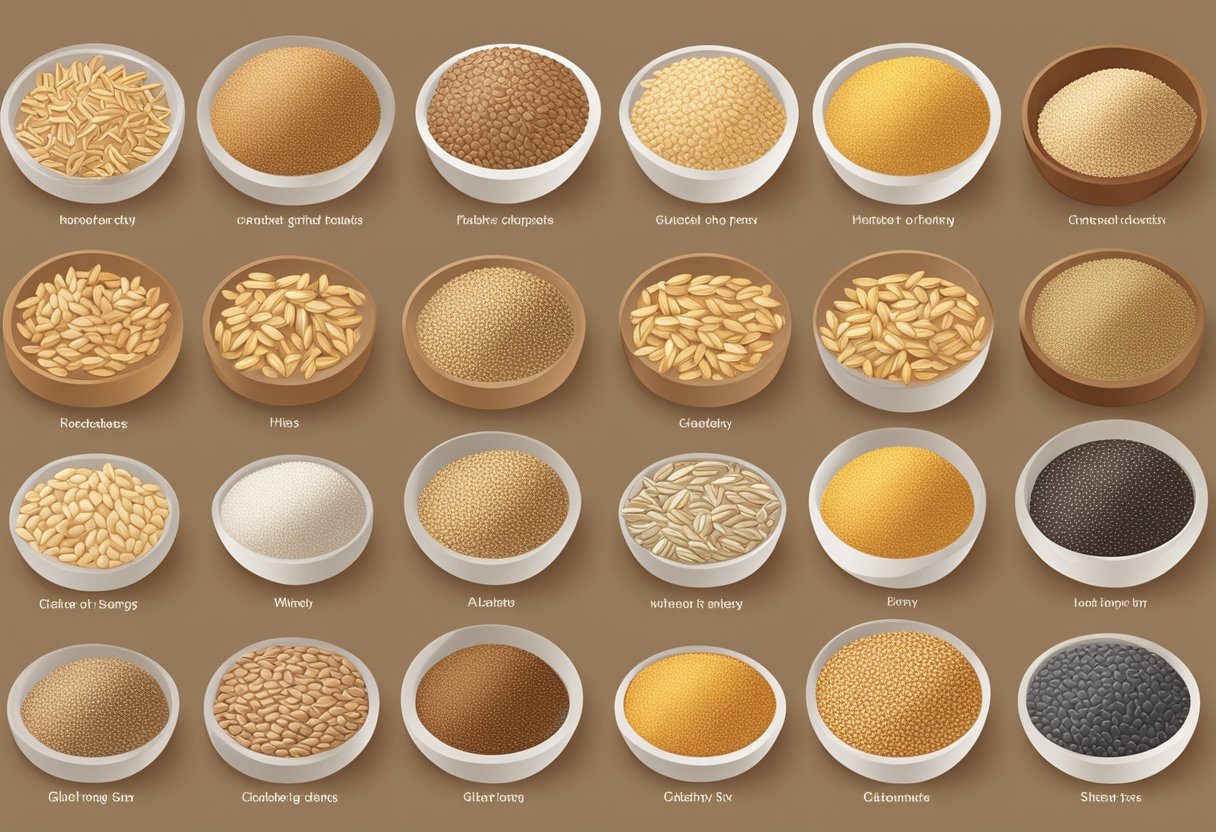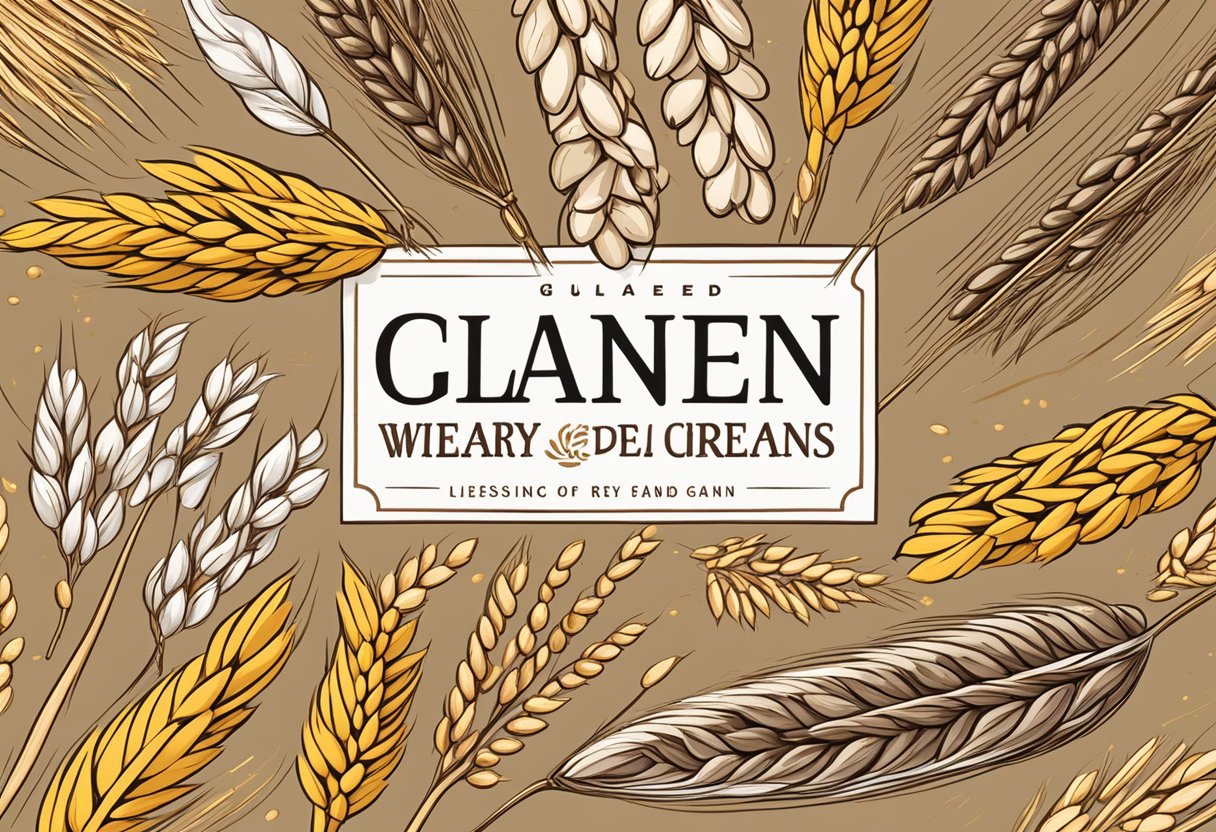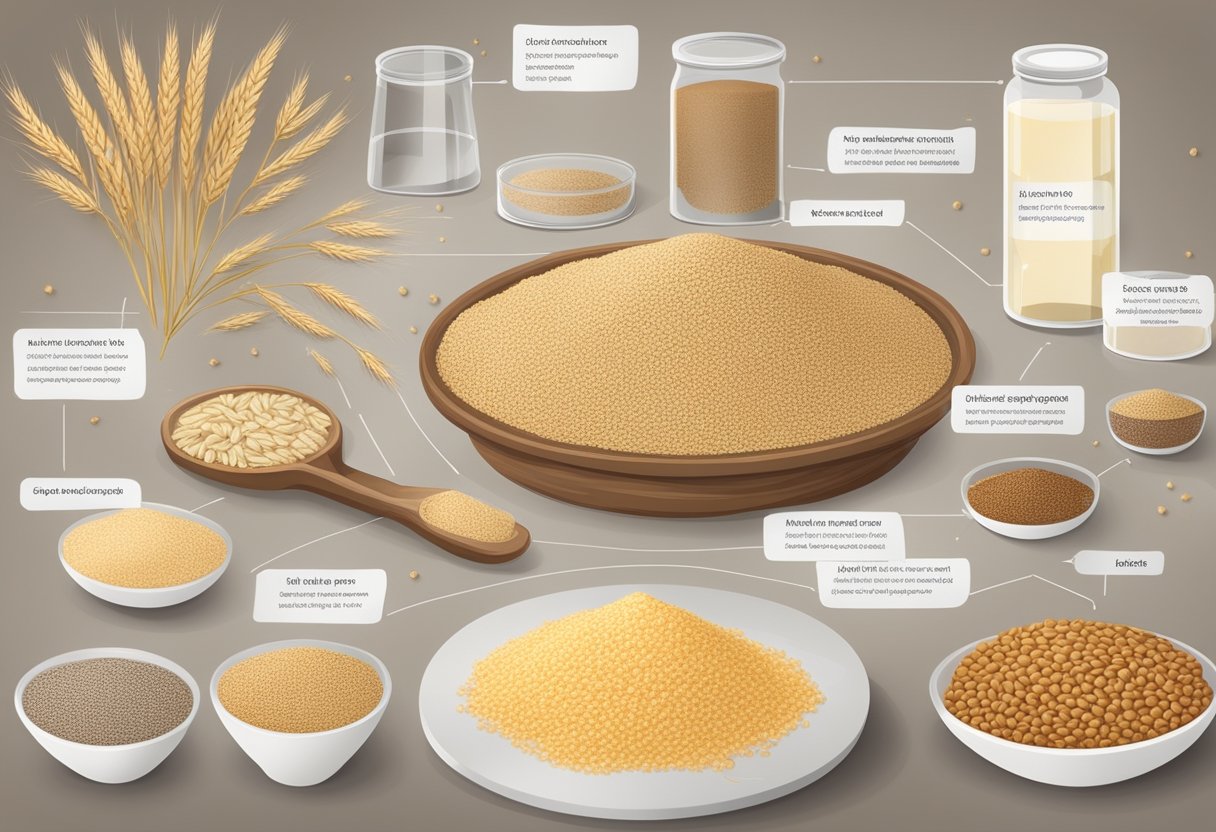Whole grains such as wheat, barley, and rye are staples in many diets around the world and are praised for their health benefits. These grains are particularly valued for their high fiber content, vitamins, and minerals which contribute to heart health and support digestive function. However, for individuals with gluten sensitivities or celiac disease, these grains present a significant health concern due to their gluten content.

Gluten is a protein found in wheat, barley, rye, and triticale, a cross between wheat and rye. It gives elastic properties to dough, helping it rise and keep its shape, often resulting in a chewy texture. While many people can enjoy gluten-containing products without any adverse effects, this is not the case for everyone.
For those with celiac disease, consumption of gluten triggers an immune response that damages the lining of the small intestine. This can lead to various gastrointestinal symptoms and potential long-term health complications if not managed by a strict gluten-free diet. Identifying gluten-free whole grains like rice, corn, and certain oats is essential for maintaining a balanced and nutritious diet for those affected.
Key Takeaways
- Gluten is a protein in wheat, barley, and rye that can cause health issues in sensitive individuals.
- A strict gluten-free diet is crucial for managing celiac disease and gluten sensitivities.
- Gluten-free individuals can consume certain whole grains, such as rice and specific oats.
Table of Contents
Understanding Gluten and Celiac Disease

This section provides detailed insight into gluten’s role in celiac disease, including what triggers the condition and its associated symptoms.
What Is Gluten?
Gluten is a group of proteins, primarily glutenin and gliadin, found in various grains such as wheat, barley, and rye. It is responsible for the elasticity and chewy texture of dough. Gluten consumption can lead to health issues for certain individuals, particularly those with gluten-related disorders.
Overview of Celiac Disease
Celiac disease is a serious autoimmune disorder where the ingestion of gluten leads to damage in the small intestine. When a person with celiac disease consumes gluten, their immune system responds by attacking the small intestine, affecting its ability to absorb nutrients. This reaction is caused by an abnormal immune response to gluten in which the body produces antibodies that damage intestinal cells.
Symptoms of Gluten Intolerance
Symptoms of gluten intolerance or non-celiac gluten sensitivity can include bloating, diarrhea, and abdominal pain. While it does not cause the autoimmune response seen in celiac disease, gluten sensitivity can still be uncomfortable and disruptive. Other signs may also be non-digestive, such as a skin rash or a general feeling of unwellness.
Whole Grains and Gluten Content
The consumption of whole grains such as wheat, barley, and rye is associated with the presence of gluten, a protein that can pose health challenges for individuals with gluten-related disorders. These grains are central to many diets, yet their gluten content necessitates careful consideration for those following gluten-free lifestyles, such as within a Mediterranean diet framework.
Role of Wheat, Barley, and Rye
Wheat stands as one of the most prevalent gluten-containing grains, found in a myriad of foods from bread to pasta. It contains several types of gluten proteins, predominantly gliadin and glutenin, which are responsible for the elasticity and rise of dough. Similarly, barley and rye also encompass gluten proteins, making them unsuitable for a gluten-free diet. Barley’s use extends to malt production and brewing, while rye often appears in cereal and bread products. For anyone adhering to a gluten-free Mediterranean diet, it is imperative to avoid or find substitutes for these grains.
Table 1: Gluten-Containing Grains in the Mediterranean Diet
| Grain | Presence of Gluten | Common Uses |
|---|---|---|
| Wheat | High | Breads, pastas, cereals, baked goods |
| Barley | High | Beers, malted products, soups |
| Rye | High | Breads, whiskey, crispbread |
Gluten Presence in Oats
While oats themselves are naturally gluten-free, the concern lies in cross-contamination, as they are often processed in facilities that handle wheat, barley, or rye. Thus, for oats to be safe on a gluten-free Mediterranean diet, they must be certified as gluten-free, ensuring they have not been tainted with gluten during processing. Oats can provide a nutritious alternative to other whole grains, offering fiber and other health benefits crucial to the Mediterranean diet’s emphasis on wholesome foods.
List of Considerations for Gluten-Free Oats in a Mediterranean Diet:
- Oats must be labeled or certified as gluten-free.
- Avoid oats processed in the same facilities as gluten-containing grains.
- Use oats to replace traditional gluten grains for a well-rounded diet.
Gluten-Free Diet Essentials
Initiating a gluten-free diet requires diligence, especially when it’s important to manage conditions like celiac disease. One must become adept at identifying gluten in various foods, understanding labeling standards, and mitigating risks of cross-contamination.
Starting a Gluten-Free Diet
When beginning a gluten-free diet, one must replace gluten-containing grains like wheat, barley, and rye with gluten-free alternatives. This includes grains such as quinoa, rice, corn, and gluten-free oats. Incorporating Mediterranean foods such as fruits, vegetables, legumes, fish, and olive oil can enrich the diet with nutrients while staying gluten-free.
Understanding Food Labels
Reading food labels is crucial for maintaining a strict gluten-free diet. Labels must be scrutinized for hidden sources of gluten, which are often found in additives or preservatives. The United States requires that foods labeled “gluten-free” contain less than 20 parts per million (ppm) of gluten. Recognizing certified gluten-free symbols can further guide safe choices.
Cross-Contamination Risks
Cross-contamination can occur when gluten-free foods come into contact with gluten-containing foods. To avoid this, one should use separate cooking utensils, storage containers, and cooking surfaces for gluten-free products. When dining out, it’s important to communicate dietary needs to ensure that meals are prepared without the risk of gluten exposure.
Identifying Gluten-Free Whole Grains
Those who follow a gluten-free diet, whether due to celiac disease or gluten sensitivity, need to know which grains are safe and nutritious. This section focuses on varieties of whole grains that do not contain gluten and their nutritional benefits.
Safe Grains for a Gluten-Free Diet
Grains free from gluten are essential for those with celiac disease or gluten sensitivities. The following grains do not contain gluten:
- Corn: Versatile and commonly consumed, corn can be found in many forms, including whole corn, cornmeal, and popcorn.
- Rice: Both brown and white rice are naturally gluten-free and can be enjoyed as part of a Mediterranean diet.
- Buckwheat: Despite its name, buckwheat is not related to wheat and is safe for those avoiding gluten.
- Quinoa: This ancient grain offers a complete protein, meaning it contains all nine essential amino acids.
- Millet: Often used in porridges and bread, millet is a traditional grain with gluten-free status.
- Sorghum: Used in flours and syrups, sorghum is suitable for gluten-free recipes.
- Amaranth: This small grain is high in protein and fiber.
- Teff: High in fiber, protein, and nutrients, teff is a staple grain in Ethiopian cuisine.
Legumes, seeds, and nuts also provide a gluten-free source of nutrients and can be integrated into a Mediterranean diet.
Nutritional Benefits of Gluten-Free Grains
These gluten-free grains offer a variety of nutrients, vitamins, and minerals:
- Fiber: Essential for digestive health, gluten-free grains such as quinoa and millet are good sources of fiber.
- Nutrients: Amaranth and teff are rich in nutrients, contributing to a well-rounded diet.
- Vitamins: B vitamins are plentiful in grains like sorghum and buckwheat, which support metabolic processes.
- Iron: Quinoa and amaranth contain iron, which is crucial for oxygen transport in the blood.
Incorporating a diverse range of gluten-free grains into a diet can provide the necessary fiber, nutrients, and vitamins to support overall health. They can also serve as a solid foundation for a balanced, gluten-free Mediterranean diet.
Gluten-Containing Foods and Alternatives

Many common foods in a typical diet include gluten through ingredients such as wheat, barley, and rye. Understanding which foods contain gluten and identifying gluten-free alternatives is crucial for those requiring a gluten-free diet.
Common Foods Containing Gluten
Gluten is present in a wide range of foods, frequently found in:
- Breads and Baked Goods: including whole wheat bread, croissants, muffins, and doughnuts.
- Cereals and Pasta: encompassing wheat-based breakfast cereals and all forms of wheat pasta.
- Processed Foods: where gluten can be an additive for texture or flavor, such as in certain sauces and processed meats.
- Snacks: like cookies, crackers, and cakes often made from wheat flour.
- Beer and Malt Beverages: as they are brewed from barley and other gluten-containing grains.
- Condiments: such as soy sauce, which traditionally includes wheat.
Individuals must check labels carefully, as gluten can be hidden in various foods, including pizzas, noodles, and other proteins that may use gluten-containing fillers.
Gluten-Free Substitutes and Products
Fortunately, for those on a gluten-free diet, there are numerous alternatives:
- Bread and Pasta: made from gluten-free grains like rice or corn.
- Gluten-Free Whole Grains: like quinoa or buckwheat can be used in place of traditional wheat grains.
- Cereals: certain cereal brands offer gluten-free oats and other alternatives.
- Snack Foods: including gluten-free versions of cookies and crackers.
- Alcoholic Beverages: such as gluten-free beer or spirits distilled from non-gluten grains.
- Condiments: Tamari can replace soy sauce, being similar in taste but typically gluten-free.
Gluten-free products are now widely available, specifically designed to exclude gluten while mimicking the taste and texture of their gluten-containing counterparts.
For gluten-free alternatives within a Mediterranean diet, individuals can focus on naturally gluten-free foods like fruits, vegetables, legumes, nuts, seeds, fish, and poultry, integrating them with the above gluten-free grains and products.
Eating Out and Social Situations
When eating out or attending social events, individuals with gluten sensitivities must exercise caution to avoid gluten-containing foods while adhering to a gluten-free Mediterranean diet.
Navigating Restaurants
At restaurants, one should be proactive in communicating dietary needs. It’s essential to verify if the restaurant offers gluten-free options that align with the Mediterranean diet, focusing on fruits, vegetables, legumes, and lean proteins. Upon arrival, they should speak with the server or chef about their needs and emphasize the importance of avoiding cross-contamination. For instance, requesting that the kitchen prepares meals using clean utensils and surfaces to prevent contact with gluten. Menus labeled with a gluten-free indicator are helpful, but one should still confirm with staff as labels may not always account for cross-contamination risks.
Handling Social Events with Dietary Restrictions
During social events, attendees should inquire about the menu in advance and, if necessary, bring their own gluten-free Mediterranean-friendly dishes. They can also reach out to the host to discuss meal preparation and the risks of cross-contamination. It is vital to be aware that foods like dips or salads at a buffet could be subject to cross-contamination through shared serving utensils. One should consider serving themselves first or requesting a separate portion to ensure the integrity of their meal.
Health Effects and Nutritional Considerations
Understanding the health effects and nutritional considerations of gluten-containing grains is essential, particularly for those with gluten intolerance and those managing celiac disease. These conditions necessitate a strict gluten-free diet to prevent adverse health implications and ensure proper nutrient intake.
Long-Term Health Implications of Gluten Intolerance
People with celiac disease experience an autoimmune response when consuming gluten, leading to intestinal inflammation and damage to the small intestine’s lining. This impairs nutrient absorption, often resulting in anemia, osteoporosis, and other nutritional deficiencies. Moreover, a continued intake of gluten can increase the risk of certain cancers and other autoimmune disorders in this population. Non-celiac gluten sensitivity, characterized by symptoms similar to celiac disease but without the intestinal damage, can still cause chronic inflammation and discomfort, urging dietary modifications.
Nutritional Management on a Gluten-Free Diet
Adhering to a gluten-free diet is the primary treatment for those with gluten intolerance. This diet requires the elimination of wheat, barley, and rye; thereby, it is crucial to seek alternative sources of nutrients typically found in these grains, such as fiber, iron, and B vitamins. For example:
- Fiber: Incorporating fruits, vegetables, and gluten-free whole grains like quinoa and brown rice.
- Iron and B vitamins: Including meat, fish, eggs, and fortified gluten-free products.
A gluten-free Mediterranean diet could provide an array of nutritionally rich, naturally gluten-free foods that can help with weight loss and overall health maintenance. This diet emphasizes fruits, vegetables, legumes, nuts, seeds, and olive oil, plus lean sources of protein like fish and poultry. It is known for its anti-inflammatory properties, which may benefit those with gluten-related disorders.
Research and Development in Gluten-Free Products

Recent efforts in food science have led to significant progress in formulating gluten-free products. These advancements help meet the dietary needs of individuals requiring or choosing a gluten-free diet.
Advancements in Gluten-Free Foods
Gluten-free grains such as quinoa and buckwheat are increasingly foundational in the development of gluten-free products. Researchers are focused on improving the taste, texture, and nutritional value of foods within a gluten-free Mediterranean diet. Notable innovations include the enhancement of bread-like qualities in products that historically fell short in comparison to their wheat-based counterparts, as seen in recent practical researches in the development of gluten-free breads.
- Texture and Flavor: Improved processing techniques have led to better texture and flavor.
- Nutrition: Additions of fiber and protein cater to health-conscious consumers.
These developments enable those on a gluten-free diet to enjoy more diverse and palatable choices, which are nearly indistinguishable from their gluten-containing alternatives.
Legal Standards and Certification
The growth of the gluten-free market has necessitated clear legal standards and certification processes:
- 20 Parts Per Million: Gluten-free products must contain less than 20 parts per million of gluten to ensure safety for consumption, especially among those with celiac disease.
- Labels and Certification: Regulatory bodies have established labeling requirements. Products that meet the stringent criteria are awarded gluten-free certification, which aids consumers in making informed decisions.
This framework provides a level of assurance that assists individuals in maintaining their gluten-free diet without undue concern for hidden gluten content.
Frequently Asked Questions
Understanding gluten and its effects is crucial for individuals with sensitivities and those considering a gluten-free diet. These FAQs address common concerns around gluten-containing grains and the dietary adjustments related to gluten intolerance and celiac disease.
What is gluten and what are the possible side effects of consuming it?
Gluten is a protein found in certain grains such as wheat, barley, and rye. It can cause side effects like bloating, abdominal pain, and headaches in individuals with gluten sensitivity or celiac disease. In non-sensitive individuals, these effects are relatively uncommon.
Which grains are safe to eat on a gluten-free diet?
Grains such as quinoa, brown rice, corn, millet, amaranth, teff, and buckwheat are considered safe for a gluten-free diet. These grains do not contain gluten and are a good alternative for those who need to avoid gluten.
What could be the consequences of a gluten-free diet for someone without celiac disease?
For someone without celiac disease, following a gluten-free diet without medical necessity may lead to a lack of essential nutrients. Whole grains that contain gluten are rich in fiber and vitamins and should not be eliminated unless required.
How does gluten affect individuals with gut sensitivity?
In individuals with gut sensitivity or non-celiac gluten sensitivity, gluten can trigger immune responses leading to intestinal damage, nutrient malabsorption, and symptoms like diarrhea and fatigue.
What are the primary grains to avoid due to their high gluten content?
Wheat, barley, and rye are the primary grains high in gluten. Different forms of wheat such as durum, emmer, and spelt also contain gluten and should be avoided by those on a gluten-free diet.
What medical conditions necessitate a strict gluten-free diet?
Celiac disease is the primary medical condition that requires a strict gluten-free diet. Other conditions like wheat allergy and non-celiac gluten sensitivity also necessitate the avoidance of gluten to prevent adverse health effects.



